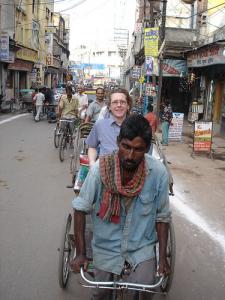You may not come to India seeking spiritual enlightenment, but you will learn to have faith. You're going to need to believe that when you get into or onto any form of hired transport, you will reach your destination – in one piece. And that when you want to cross to the other side of the road, you can do so without Crossing to the Other Side.
Thinking too hard about whether you're going to have a wreck when you're in auto rickshaws, will leave you in one in no time at all. The best thing is to abandon your fate to the driver, however young or tired he may appear, and remind yourself that although everything looks on the verge of having an accident at any given moment, not many actually happen. Unless, that is, you count the Blue Line buses, the drivers of which are infamous for absconding from the scenes of their often lethal mishaps. Those aside, actual collisions are mercifully rare, so much so that it almost seems like a surprise when you do witness one. Almost. Just be grateful that you're not driving. I told myself this time and again, and it made being a passenger seem much the safer option. To have driven oneself would have been to tip the balance, to have flapped the butterfly wing that would have waved total chaos crashing inevitably around the entire traffic system of India.
Nearer my God to Thee
If you have a God, travelling by cycle rickshaw will put you closer to him, her or it. You will be elevated into the sun and fumes atop your suitably austere metal pew from where, according to the condition of the road, you may practice your oaths at leisure. Keeping your hands together in prayer position at this point is recommended, not least because this will keep you from the temptation of allowing fingers to stray beyond the confines of your vehicle. Not heeding this advice may leave you at a loss in terms of future solo commandment-counting. Oh, and keep your Jesus-sandaled feet away from the chain.

 Author, fearlessly researching in Varanasi
Author, fearlessly researching in Varanasi
If you're both terribly unlucky and extremely lucky in quick succession, you may be reincarnated as a cow. The abundant cattle in Varanasi, for example, are an indication of both the protection afforded them by their divine status, and the constant and tenuous balancing act of the state of near-chaos maintained on the streets. While you'll never see a cow actually hit, and they are the only things that anyone makes way for, those with paler hides betray near-misses with a collection of tyre-marks and grazes on their flanks.
Horn Please
Amongst the popular signage on the rear of vehicles, "Horn Please" is the most ubiquitous. It is everywhere, for the horn is king. What wing mirrors do exist are turned inwards to prevent emasculation by competitor vehicles. They're occasionally used to check hair, or teeth. The horn is the lingua franca of Indian driving. Its chief message, though, is this: I'm behind you, but not for long, so watch out. Horns are sounded so often and for so long that I came to think that their switches were wired to turn them off.
The horn is almost an indication of power, too – the louder, the fuller, the better. Some are so tired from over-use, they sound like the bleating of a dying electronic sheep. Others are positively frightening. And the trucks – theirs have a language all their own, trading in multi-toned mini-symphonies of noise, like detuned whale song on acid. I thought briefly that there might be a fortune to be made from a horn-refurbishment business, or from offering a "pimp-my-horn" upgrade service. Then when paying my fare I realised why it hasn't happened. In any case, if there were any money in the idea, some enterprising soul would already be doing it.
Stations of the Cross
Crossing the road is more than just a matter of belief. Observance of ritual is also important. The trick is to wait until sufficient numbers have gathered at your chosen crossing-point. Ideally one wants to be as far from the leading edge of this congregating wave of humanity as possible, since this will offer a protective buffer when the group finally reaches its critical mass and spills into the road. All that remains is to hold one's nerve and try not to make the distance too quickly, weaving Frogger-style through the lanes. This works especially well on, say, Connaught Place in central New Delhi. Note that one's crossing pace should be proportionate to the speed and density of the traffic flow. On the dual carriageway city ring road, it's better to run like hell. The speeds mean that gaps are much more short-lived, as will you be if you get your methods mixed up. Don't expect any quarter at zebra crossings either, unless backed by lights and preferably a policeman with a gun. In other cases, road markings are purely decorative.
When dealing with Indian traffic, then, faith is important. Faith, though, should never be blind. The only possible exception to this rule is closing one's eyes in the back of an auto rickshaw. Then again, if you'll pardon the expression, think what you'd be missing.